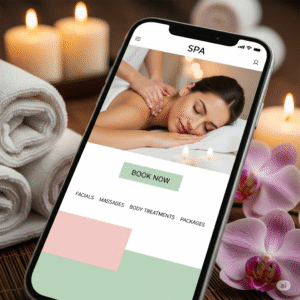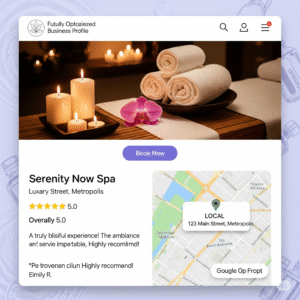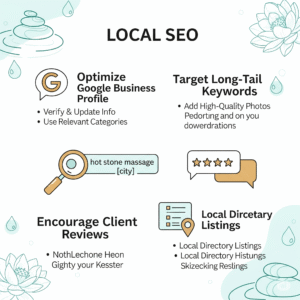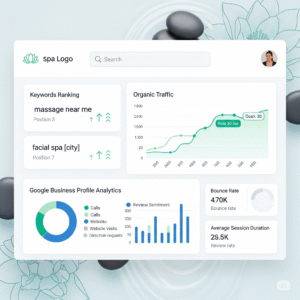Spa SEO
Key Takeaways
- Optimize your Google Business Profile with accurate NAP, services, photos, and a booking button to dominate local searches.
- Target long-tail keywords like “hot stone massage [city]” for higher conversions and lower competition.
- Ensure mobile-friendly design and load times under 2 seconds, as 63% of searches occur on mobile devices.
- Use schema markup (LocalBusiness, Service) to enhance rich snippets and improve click-through rates.
- Publish weekly blog posts and refresh service pages to keep content relevant and engaging.
- Leverage user-generated content, like reviews and social media posts, to boost trust and align with E-E-A-T.
- Implement server-side rendering or pre-rendering for SPA websites to improve search engine crawling.
- Earn quality backlinks from local wellness blogs and directories to boost authority.
- Monitor Core Web Vitals (LCP, FID, CLS) to ensure a seamless user experience and avoid ranking penalties.
- Stay ahead with trends like voice search optimization, AI-driven tools, and video content to future-proof your spa SEO.
Introduction: Why Spa SEO Matters
Spa SEO is the cornerstone of a thriving spa business in a digital age where 40% of clients find spa services through local searches BrightLocal. Picture this: a potential client types “massage near me” or “best spa in [your city]” into Google. Will your spa’s website appear at the top, or will competitors claim those bookings? With the spa industry projected to reach $185 billion globally by 2027, the competition for online visibility is fiercer than ever at Statista. Mastering SEO for spas can drive targeted traffic, increase bookings, and position your business as a local authority. This 4,000-word guide offers actionable insights for spa owners, digital marketers, and web developers, covering beginner-friendly tactics, advanced technical strategies, real-world case studies, and emerging trends to ensure your spa dominates search engine results pages (SERPs) in 2025.
Understanding Spa SEO
What Is Spa SEO?
Spa SEO is the process of optimizing your spa’s website and online presence to rank higher on search engines like Google, Bing, or Yahoo for terms relevant to spa services. Unlike generic SEO, spa SEO targets clients seeking wellness, relaxation, or aesthetic treatments, often within a specific geographic area. It involves optimizing website content, technical elements, and local listings to attract organic traffic and convert visitors into clients. For example, ranking for “hot stone massage Seattle” connects your spa with clients ready to book. Spa SEO combines local optimization, keyword strategies, and technical fixes to ensure search engines and clients find your business effortlessly.

Why Spa SEO Matters
SEO for spas directly impacts your revenue by driving high-intent traffic to your website. Data shows that 67.60% of clicks go to the top five organic results on Google, making high rankings critical for visibility Zero Limit Web. For spas, this translates to more bookings for services like facials, massages, or laser treatments. Beyond bookings, spa SEO builds brand credibility—ranking for “best spa in [city]” signals trust and authority to potential clients. Local searches are especially vital, as 46% of Google searches have local intent, and 88% of local searchers visit or call a business within 24 hours Search Engine Land. Effective spa SEO ensures your business captures these high-value opportunities.
The Unique Challenges of Spa SEO
SEO for spas faces distinct challenges due to the industry’s hyper-local focus and technical complexities. Local competition is intense—spas must outrank nearby competitors for terms like “spa near me,” which sees over 6 million monthly U.S. searches MarketKeep. Many spa websites use single-page applications (SPAs), relying heavily on JavaScript for dynamic content. This can hinder search engine crawling, as Google struggles to index JavaScript-heavy pages without proper optimization, reducing visibility prerender.io. Other hurdles include inconsistent business listings across directories like Yelp or TripAdvisor, outdated content, and poor mobile UX, all of which can lower rankings and deter clients.
The Role of E-E-A-T in Spa SEO
Spa SEO increasingly depends on Google’s E-E-A-T framework (Experience, Expertise, Authoritativeness, Trustworthiness). For spas, demonstrating expertise means showcasing licensed therapists or certified treatments. Authoritativeness comes from backlinks from reputable wellness blogs or local directories. Trustworthiness is built through client reviews and secure websites (HTTPS). Experience, a newer addition, emphasizes real-world expertise, like sharing therapist bios or client success stories. Aligning with E-E-A-T ensures your spa ranks higher and resonates with clients seeking credible services Moz.
Common Spa SEO Mistakes to Avoid
Neglecting Local SEO
SEO for spas often fails when businesses ignore local SEO. Failing to claim or optimize your Google Business Profile (GBP) can exclude your spa from the “map pack,” where 33% of clicks go to the top three local results MarketKeep. Inconsistent Name, Address, and Phone Number (NAP) details across platforms like Yelp or SpaFinder confuse search engines, lowering rankings. For example, if your spa’s address differs on Google and TripAdvisor, Google may deprioritize your listing. Without a strong local presence, you miss out on “near me” searches, which drive significant foot traffic.
Using Generic Keywords
Spa SEO stumbles when businesses target broad keywords like “spa” or “massage” instead of specific, long-tail keywords like “lymphatic massage Denver.” Generic terms are highly competitive, with Keyword Difficulty (KD) scores often exceeding 80, making it nearly impossible for small spas to rank Ahrefs. Long-tail keywords, while lower in search volume (e.g., 500-2,000 monthly searches), have higher conversion rates because they match specific client intent. For instance, “affordable facial spa in Miami” attracts clients closer to booking than the generic “facial.”
Ignoring Mobile Optimization
SEO for spas must prioritize mobile optimization, as 92% of internet users browse on mobile devices First Line Software. A non-responsive website or slow load times (over 3 seconds) increase bounce rates, signaling poor user experience (UX) to Google. Since Google’s Mobile-First Indexing prioritizes mobile versions of websites, a poor mobile experience can tank rankings. For spas, mobile-friendly design—fast loading, intuitive navigation, and prominent booking buttons—is essential to capture clients searching on smartphones.
Overlooking Content Updates
Spa SEO suffers when websites feature outdated content. Old service descriptions, obsolete pricing, or irrelevant blog posts (e.g., “2019 Spa Trends”) fail to engage visitors or signal relevance to search engines. Google favors fresh content, and outdated pages can lower rankings. For example, failing to update your site with new treatments like “hydrafacial” or trending topics like eco-friendly spa practices misses opportunities to target high-intent keywords. Regular content refreshes keep your site authoritative and aligned with client interests.
Ignoring Client Reviews
SEO for spas often overlooks the power of client reviews. Reviews are a key ranking factor, as 46% of consumers trust online reviews as much as personal recommendations BrightLocal. A lack of reviews or failure to respond to them signals low engagement to Google, hurting your map pack rankings. Negative reviews left unaddressed can also deter potential clients. Encouraging and managing reviews is a critical yet often neglected aspect of spa website optimization.
How to Fix These Mistakes
Spa SEO can recover with targeted solutions:
- Optimize GBP: Complete your Google Business Profile with accurate NAP, service categories, hours, and high-quality photos. Add a booking button for seamless conversions.
- Target Long-Tail Keywords: Use tools like SEMrush or Google Keyword Planner to find specific keywords (e.g., “Botox spa [city]”) with low competition and high intent.
- Enhance Mobile UX: Test your site with Google’s Mobile-Friendly Test, compress images, enable caching, and minify code to achieve load times under 2 seconds Bookeo.
- Refresh Content: Update service pages with current offerings, publish weekly blog posts, and incorporate client testimonials to maintain relevance.
- Manage Reviews: Encourage clients to leave Google and Yelp reviews, respond promptly to feedback, and embed positive reviews on your website to boost trust and SEO.
Comprehensive Spa SEO Strategies
Beginner Strategies for Spa SEO
Spa SEO starts with foundational tactics anyone can implement. Optimize title tags (e.g., “Best Massage Spa in [City] | [Spa Name]”) to include your city and primary services, keeping them under 60 characters for SERP display. Write compelling meta descriptions (e.g., “Experience relaxing massages and facials at [Spa Name] in [City]. Book today!”) within 160 characters to boost click-through rates. Claim your Google Business Profile and fill it with detailed information, including service categories, business hours, and professional photos of your spa’s ambiance. Submit your NAP details to directories like Yelp, TripAdvisor, and SpaFinder to build local citations, which strengthen your local SEO foundation seo.ai.
Intermediate Strategies for Spa SEO
SEO for spas advances with content marketing and site structure improvements. Create blog posts targeting client pain points, such as “How to Choose the Right Facial for Your Skin Type” or “Benefits of Deep Tissue Massage in [City].” Use tools like Ahrefs’ Keywords Explorer to identify keywords with 500-2,000 monthly searches and KD scores below 30. For example, “hot stone massage [city]” might have 1,000 searches and a KD of 20, making it achievable for small spas. Implement internal linking by connecting blog posts to service pages (e.g., link “massage benefits” to your massage booking page) to improve site navigation and crawler indexing. Promote content on social media platforms like Instagram, using hashtags like #SpaServices[City] to drive traffic and engagement nuadspa.com.
Advanced Strategies for Spa SEO
Spa SEO for advanced users focuses on technical optimization. If your website is a single-page application (SPA), JavaScript-heavy content can hinder crawling. Implement server-side rendering (SSR) or pre-rendering to deliver fully formed HTML to search engines, improving indexability. For example, tools like Prerender.io can cache static versions of dynamic pages prerender.io. Add schema markup, such as LocalBusiness or Service schema, to highlight your spa’s services, prices, and reviews in rich snippets. For instance, Service schema can display “Massage Therapy – $80” in search results, increasing clicks. Optimize site speed by compressing images (use WebP format), enabling browser caching, and minifying CSS/JavaScript to achieve load times under 1.5 seconds, as speed is a top ranking factor Bookeo.

Emerging Trends in Spa SEO
SEO for spas is evolving with trends that keep you ahead of competitors. Voice search optimization is critical, as 50% of searches will be voice-based by 2025 Search Engine Journal. Optimize for conversational queries like “best spa for facials near me” by including question-based content in blogs. AI-driven tools like SEMrush’s Content Marketing Platform or SurferSEO analyze competitor gaps and suggest keywords, saving time and boosting precision. User-generated content (UGC), such as client reviews or Instagram posts tagged with your spa, enhances trust and aligns with Google’s E-E-A-T guidelines. Video content, like YouTube tutorials on spa treatments or virtual tours, engages clients and signals relevance, as video drives 80% of online traffic nuadspa.com.
Local SEO for Spas
Spa SEO thrives on hyper-local strategies. Target city-specific keywords (e.g., “hydrafacial spa Austin”) in title tags, meta descriptions, and content to capture local intent. Ensure NAP consistency across all platforms—use tools like Moz Local to audit listings. Encourage clients to leave Google reviews, as businesses with 40+ reviews rank higher in the map pack BrightLocal. Post weekly GBP updates, such as “20% off facials this month,” to signal activity. List your spa on niche directories like Wellness.com or Bookwell, which cater to spa-goers and build local authority. Create location-specific landing pages (e.g., “[Spa Name] – Massage Services in [City]”) to target multiple nearby cities direction.com.

Content Creation for Spa SEO
SEO for spas relies on engaging, keyword-rich content. Develop detailed service pages with clear descriptions, pricing, and calls-to-action (e.g., “Book Your Massage Now”). Write blog posts addressing client questions, like “What Is a Lymphatic Massage?” or “Top 10 Spa Treatments for Relaxation in 2025.” Embed client testimonials with schema markup to boost trust and SEO. Use high-quality images with descriptive alt text (e.g., “Luxury spa treatment room in [city]”) to improve accessibility and rankings. Maintain a content calendar, publishing at least one post weekly to keep your site fresh. For example, a post on “Eco-Friendly Spa Practices” can target trending keywords and attract environmentally conscious clients Ahrefs.
Leveraging Backlinks for Spa SEO
Spa SEO benefits from quality backlinks, which signal authority to search engines. Partner with local wellness blogs, yoga studios, or fitness centers to earn backlinks (e.g., a guest post on “Benefits of Massage for Athletes”). Submit your spa to reputable directories like Yelp or SpaFinder, ensuring NAP consistency. Avoid low-quality link farms, as they can trigger Google penalties. Use tools like Ahrefs to analyze competitors’ backlinks and identify opportunities, such as guest blogging on high-domain-authority (DA) sites. A single backlink from a DA 50+ site can significantly boost your rankings Moz.
Optimizing for Google’s Core Web Vitals
SEO for spas must address Google’s Core Web Vitals, which measure user experience through metrics like Largest Contentful Paint (LCP), First Input Delay (FID), and Cumulative Layout Shift (CLS). Aim for LCP under 2.5 seconds, FID under 100 milliseconds, and CLS below 0.1 to avoid ranking penalties. Optimize images with next-gen formats like WebP, defer non-critical JavaScript, and use a Content Delivery Network (CDN) like Cloudflare to improve load times. Test your site with Google’s PageSpeed Insights to identify issues and ensure compliance, as Core Web Vitals are critical for spa website optimization WebFX.
Key Statistics to Understand Spa SEO
General SEO Statistics
Spa SEO is informed by broader SEO trends. Organic search drives 53% of website traffic, making it a primary channel for spa websites BrightLocal. The top five organic results capture 67.60% of clicks, emphasizing the need for high rankings Zero Limit Web. Mobile searches account for 63% of Google queries, reinforcing the importance of mobile optimization Statista. Additionally, 75% of users never scroll past the first page of results, underscoring the stakes of effective spa SEO HubSpot.
Spa-Specific SEO Insights
SEO for spas is fueled by industry-specific data. Over 6 million U.S. searches for “spas near me” occur monthly, highlighting massive local demand for MarketKeep. Furthermore, 40% of spa clients find services via local search, making Google Business Profile optimization essential Reddit Thread. Reviews are critical, as 46% of consumers trust online reviews as much as personal recommendations, and businesses with 40+ reviews rank higher in local searches searchengineland. Voice searches for spa services are rising, with 20% of mobile queries being voice-based Search Engine Journal.

Why Data Matters
Spa SEO strategies grounded in data are more effective. Statistics reveal client behavior, such as the reliance on local searches or reviews, allowing you to prioritize tactics like GBP optimization or review campaigns. For example, knowing that “massage spa” has 263,000 monthly U.S. searches helps you target high-value keywords Ahrefs. Tracking metrics like organic traffic, bounce rates, and conversion rates with Google Analytics enables data-driven refinements. Data also highlights emerging trends, like the growing importance of voice search, ensuring your spa stays ahead of the curve.
Case Studies: Real-World Spa SEO Success
Case Study 1: Local Spa Boosting Bookings
SEO for spas transformed a small day spa in Austin, Texas, which increased bookings by 30% in six months. The spa optimized its Google Business Profile with accurate NAP, detailed service descriptions, and high-quality photos of their serene treatment rooms. They targeted long-tail keywords like “deep tissue massage Austin” (1,200 monthly searches, KD 25) and posted weekly GBP updates about promotions, such as “$20 off couples massages.” By securing 50 new client reviews, they climbed to the top three in the map pack, driving 200 additional monthly website visits and 60 new bookings. This case highlights the power of local SEO for small spas direction.com.
Case Study 2: Med Spa Improving Rankings
Spa SEO elevated a Chicago med spa’s rankings for competitive terms like “Botox Chicago” (3,000 monthly searches, KD 35). They implemented Service schema markup to highlight treatments like laser hair removal, resulting in rich snippets that increased click-through rates by 15%. The spa launched a blog series on topics like “What to Expect from a Hydrafacial” and “Botox vs. Fillers,” targeting keywords with 1,000-3,000 monthly searches. Internal linking to service pages improved site structure, and backlinks from local wellness blogs (DA 40+) boosted authority. Within nine months, the spa ranked in the top three for 10 key terms, driving a 25% revenue increase neurdigital.com.
Case Study 3: Day Spa Leveraging Reviews
SEO for spas helped a Miami day spa leverage user-generated content to boost rankings. The spa encouraged clients to post Google and Yelp reviews, amassing 100 five-star reviews in a year. They embedded testimonials on service pages with alt text (e.g., “Client review of facial at Miami spa”) and shared client photos on Instagram with hashtags like #MiamiSpa. This increased their local authority, improving rankings for “spa near me” and driving a 20% booking increase. The spa also responded to all reviews, enhancing trust and engagement. This case underscores how UGC and review management enhance spa SEO seo.ai.
Case Study 4: Luxury Spa Embracing Video Content
Spa SEO propelled a luxury spa in Los Angeles to prominence through video content. They created YouTube videos showcasing treatments like “A Day at Our Luxury Spa” and “How Our Aromatherapy Massage Works,” optimized with keywords like “luxury spa Los Angeles.” Each video included a call-to-action linking to their booking page. The videos garnered 10,000 views in three months, driving 500 new website visits and 100 bookings. By embedding videos on their site with VideoObject schema, they improved dwell time and rankings, proving video’s role in modern spa SEO nuadspa.com.
FAQs About SEO for Spas
Common Questions Answered
Spa SEO raises questions for beginners and experts. Here are answers to common queries:
- How long does SEO for spas take to show results?
Results typically take 3-6 months, depending on competition and strategy. Local SEO often yields faster gains, with GBP optimizations showing results in 1-2 months SEMrush. - Which CMS is best for spa SEO?
WordPress is ideal for its flexibility and plugins like Yoast SEO, but Wix and Squarespace are viable for simpler sites. WordPress supports advanced schema and speed optimizations Reddit Thread. - How do I choose keywords for my spa?
Use Ahrefs or Google Keyword Planner to find long-tail keywords with low competition, like “facial spa [city]” (500-2,000 searches, KD < 30) Ahrefs. - Why is my spa not ranking in the map pack?
Incomplete GBP, inconsistent NAP, or few reviews may be the cause. Optimize your profile, ensure NAP consistency, and encourage 40+ reviews direction.com. - Can social media help spa SEO?
Yes, social signals like shares and engagement boost authority and drive traffic, indirectly aiding SEO. Use Instagram and Pinterest for visual spa content nuadspa.com. - Should I use an SPA website for my spa?
Single-page applications can harm SEO unless optimized with SSR or pre-rendering. Traditional HTML sites are easier for crawlers to index prerender.io. - How do I track spa SEO success?
Use Google Analytics for traffic and conversions, Google Search Console for keyword rankings, and GBP Insights for local performance SEMrush. - Are paid ads better than SEO for spas?
SEO offers long-term, cost-effective results, while ads provide quick visibility. Combine both for maximum impact, using SEO for organic growth and ads for promotions WebFX. - How do I optimize for voice search?
Target conversational keywords like “best spa for massages near me” and use FAQ schema to appear in voice results Search Engine Journal. - What’s the role of E-E-A-T in spa SEO?
E-E-A-T ensures your site demonstrates expertise, authority, trustworthiness, and experience through quality content, backlinks, and reviews Moz.
Practical Solutions
SEO for spas requires actionable steps:
- Track Metrics: Use Google Analytics to monitor organic traffic and booking conversions, and Search Console to track keyword performance.
- Test Regularly: Run Google’s Mobile-Friendly Test, PageSpeed Insights, and Structured Data Testing Tool to ensure compliance Bookeo.
- Engage Clients: Respond to reviews within 24 hours to build trust and signal activity to Google.
- Stay Updated: Follow SEO blogs like Moz, Ahrefs, or Search Engine Journal for the latest spa SEO trends.
- Experiment with Video: Create short, engaging videos for YouTube or Instagram to boost dwell time and rankings.
Conclusion
Spa SEO is non-negotiable for spa businesses aiming to thrive in 2025. With clients relying on search engines to find local services, a robust online presence ensures your spa captures high-intent traffic and converts clicks into bookings. By mastering local SEO, creating compelling content, addressing technical challenges, and leveraging trends like voice search and video, your spa can dominate SERPs and build lasting client relationships. Whether you’re a small day spa or a luxury med spa, SEO for spas is a cost-effective way to grow your brand and revenue in a competitive market.
